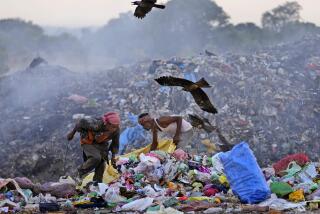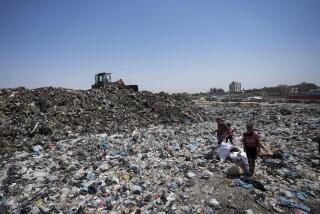For many in India, landfill is a livelihood and a home
- Share via
NEW DELHI — The children didn’t notice the ravens and occasional vulture circling overhead, or the stream of black ooze that flowed nearby, or the inescapable stench of decay. They were squealing over a 4-cent ride on a small, hand-powered Ferris wheel.
The kids are growing up in New Delhi’s 70-acre Ghazipur landfill, a post-apocalyptic world where hundreds of pickers climb a 100-foot-high trash pile daily, dodging and occasionally dying beneath belching bulldozers that reshape the putrid landscape.
On “trash mountain,” families earn $1 to $2 a day slogging through waist-deep muck. But the residents also marry, have children on their dirt floors, pray and celebrate life’s other milestones.
“I am very proud to be a rag picker; we keep you healthy,” said Jai Prakash Choudhary, who has spent years scouring Delhi’s dumps in search of cast-off bottles, metal, even human hair.
An outgrowth of India’s rapidly expanding middle class with its embrace of Western-style consumerism is ever more waste: New Delhi produces about 9,200 tons of trash daily, up 50% from 2007. The garbage is expected to double by 2024, leaving Ghazipur and two other landfills overflowing.
That’s afforded the country’s 1.7 million rag pickers — with 350,000 in New Delhi alone — more pickings, allowing some to dream of one day joining those middle-class ranks.
Rising expectations and hunger for a better life are seen in small ways at Ghazipur, charity workers said. Children balk at donations of unfashionable clothing. Twentysomethings sport stylish haircuts. Many listen to the latest pop tunes on cheap cellphones.
Choudhary is a symbol of that slow rise to the middle class, the desire for more. The rag picker, who’s in his 30s, ran for councilman in this month’s municipal elections here. Although he lost, his candidacy is an inspiration to other rag pickers, and he’s promised to try again in a continuing effort to fight for their rights.
“Dirt comes from the top,” Choudhary said. “Politics is a noble profession, but Indian politicians are not. I won’t disappoint people.”
The first rung for many, including Choudhary, is trash mountain. Most of those living in the shanties ringing the garbage dump are Muslims from impoverished central Bihar state or illegal immigrants from Bangladesh, who learn quickly which wholesalers will pay the most for their trash, how to scratch out a few feet of living space, where to scrounge for water and power.
In the trickle-down world of trash, they’re at the bottom. Because New Delhi has no real door-to-door waste-collection system, the most “desirable” refuse is snapped up by domestic workers or neighborhood pickers, who then take the leftovers to select waste sites around the city. From there, trash trucks dump the rest at Ghazipur, where residents pick over the leavings.
“No one wants to be here if they can help it,” said Ram Karan, 35, as several sheep munched on trash nearby. “It’s a necessary evil.”
Residents jealously guard their small, makeshift homes, including Sheikh Habibullah, who was busy rebuilding his after a fire razed the neighborhood, crafting a door from a Bollywood poster board.
His two-room hut, with dirt floors, rice-bag walls and a palm-leaf roof, houses six family members. Half their $60 monthly earnings go to a local boss for “rent” and permission to siphon off city electricity powering a single light bulb.
“In the slums, you always get ripped off,” said Bharati Chaturvedi, director of Chintan, a charity focused on waste-pickers.
Once collected, trash is sorted, often by children, into piles up to 12 feet high: plastic bottles, cups, bottle caps, bent cutlery. Buyers pay 5 cents a pound for plastic bags and $18 per pound for human hair, used in wigs.
Some finer points of picker etiquette: Don’t talk to bulldozer drivers — everyone has a job to do — and scrounge only what’s in front of you.
“Getting tricky leads to turf fights,” said Habibullah, 30, in brown pants, black flip flops and an imitation gold chain. “Otherwise, there’s no real skill. It’s not exactly silver mining.”
Child labor is rife, as is gastrointestinal illness. Cancer, birth defects and asthma rates are high. Milk from dairies ringing the landfill — alongside several slaughterhouses and a crematorium — is tinged with lead and dioxin. Most can’t afford a change of clothes, let alone a doctor.
“We bathe under the pump,” said Jamshed Khan, 45. “The water tastes metallic, but we drink it.”
Even as passing drivers hold their noses en route to call-center jobs in the nearby Delhi satellite of Noida, believing they’ve escaped Dante’s third ring of hell, Ghazipur residents speak of opportunity, the city’s allure, liberation from village pettiness.
“It’s much freer here,” said Sheikh Abdul Kashid, 60, framed by the orange hues of a chemical-induced sunset. “And I’ve given four children some education. I could never do that back home.”
Few issues in India are far from politics, and garbage is no exception. Given an energy shortage, overflowing landfills and a bid for carbon credits under the global Kyoto Protocol climate pact, several trash-to-energy plants are planned, including one at 30-year-old Ghazipur.
Supporters say these will modernize an inefficient system. Critics say they’re a plot by hard-line Hindu politicians to keep down Muslims, would release even more dioxin and would destroy rag-picker livelihoods.
Pickers complain that even now they can’t keep pace with rising food costs.
“I manage to make enough to feed us,” said Habibullah, as a small boy walked by naked except for flip-flops. “But I can never get ahead.”
The more ambitious are no longer content to wait for belching garbage trucks, so they head into neighborhoods to get higher-quality waste from residents, earning more money.
“There’s a high probability they could be middle class in a generation or two,” Chintan’s Chaturvedi said. “We can’t bring miracles. But as Delhi develops, there’s great need for even moderately educated people.”
Out on the campaign trail a few days before the election, flanked by hundreds of supporters, candidate Choudhary shook hands, held babies and touched the feet of elderly voters, a sign of humility.
“I will continue to work and spread awareness about rag-picker rights,” he said. “I hope I’m an inspiration to others. Can you imagine no one picking up the waste from your house, even for a day?”
Tanvi Sharma of The Times’ New Delhi bureau contributed to this report.
More to Read
Sign up for Essential California
The most important California stories and recommendations in your inbox every morning.
You may occasionally receive promotional content from the Los Angeles Times.










